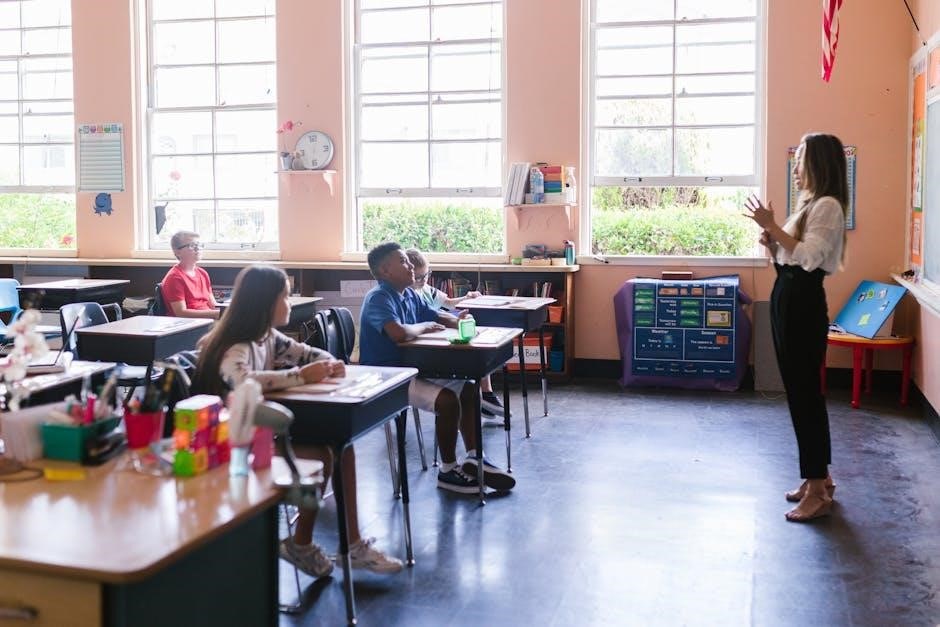Literacy instruction forms the foundation of education, equipping students with essential reading, writing, and comprehension skills. Effective programs are comprehensive, addressing diverse learning needs and fostering critical thinking and communication abilities, preparing students for lifelong learning and community engagement.
1.1 Importance of Literacy in Education
Literacy is the cornerstone of education, empowering students to navigate academic and real-world challenges effectively. It fosters critical thinking, communication, and problem-solving skills, essential for lifelong learning; Literate individuals can engage fully in society, accessing information, participating in civic activities, and pursuing personal and professional goals. Early literacy development is particularly crucial, as it lays the groundwork for future academic success and socio-economic mobility. By mastering reading, writing, and comprehension, students gain the tools to explore diverse subjects and cultivate a deeper understanding of the world. Literacy instruction ensures equity, enabling all students to thrive regardless of their background. It is not just a skill but a gateway to opportunities, personal growth, and active participation in a rapidly evolving global community.
1.2 Overview of Comprehensive Literacy Instruction
Comprehensive literacy instruction is a holistic approach that integrates reading, writing, speaking, and listening skills to create a cohesive learning experience. It encompasses phonemic awareness, fluency, vocabulary development, and comprehension strategies, ensuring students build a strong foundation for lifelong learning. This approach is inclusive, catering to diverse learning needs through differentiated instruction and scaffolding techniques. It emphasizes the importance of explicit teaching, guided practice, and independent application, supported by ongoing assessment and feedback. Comprehensive literacy instruction also fosters critical thinking, creativity, and collaboration, preparing students to engage effectively with complex texts and real-world challenges. By addressing the unique needs of all learners, it promotes equity and sets the stage for academic success and personal growth.
Key Components of Literacy Instruction
Literacy instruction involves phonemic awareness, reading comprehension, and writing skills, ensuring students develop the ability to decode, interpret, and communicate ideas effectively across various contexts and materials.
2.1 Phonemic Awareness and Its Role
Phonemic awareness is the ability to identify and manipulate individual sounds (phonemes) in spoken words, serving as a foundational skill for reading and writing. It enables students to decode words, recognize patterns, and spell accurately. Research highlights its critical role in early literacy development, as it directly impacts reading fluency and comprehension. Effective instruction in phonemic awareness involves activities like segmenting sounds, blending phonemes, and identifying rhymes. These practices help students develop a strong understanding of how language works, which is essential for all learners, especially those struggling with literacy. By incorporating engaging and systematic strategies, educators can ensure students build a solid foundation for lifelong literacy skills.
2.2 Reading Comprehension Strategies
Reading comprehension is the ability to understand, interpret, and critically engage with written text. Effective instruction in reading comprehension involves teaching strategies that enhance students’ ability to extract meaning from texts. Key strategies include setting a purpose for reading, asking questions, summarizing content, and visualizing information. Additionally, techniques such as identifying main ideas, making inferences, and recognizing text structure help students deepen their understanding. Teachers can model these strategies explicitly and provide scaffolded support to ensure all learners, regardless of skill level, can access and interpret complex texts. By fostering active engagement with texts, these strategies empower students to become independent readers capable of analyzing and applying knowledge across various subjects and contexts.
2.3 Developing Writing Skills
Developing writing skills is a critical component of literacy instruction, enabling students to express ideas, communicate effectively, and convey knowledge. Effective writing instruction involves explicit teaching of writing processes, including brainstorming, drafting, revising, editing, and publishing. Teachers should model writing strategies and provide scaffolded support, such as graphic organizers and writing frames, to help students structure their thoughts. Feedback is essential, with clear guidelines on improving content, organization, and language use. Encouraging writing across various genres and purposes helps students adapt their writing style to different contexts. Additionally, integrating technology, such as writing software and digital tools, can enhance engagement and provide interactive ways to practice writing. By fostering a supportive environment, teachers can help students build confidence and fluency in their writing abilities, preparing them for academic and real-world applications.
Community and Leadership in Literacy
Community and leadership in literacy foster collaborative efforts, empowering educators and engaging families to support student success and promote a culture of lifelong learning together.
3.1 Role of Community Advisory Boards
Community advisory boards play a pivotal role in shaping effective literacy programs by providing strategic guidance and fostering collaboration between educators and local stakeholders. These boards ensure that literacy initiatives align with community values and address the diverse needs of all students. By engaging in regular discussions and reviews, they help identify gaps in resources and recommend improvements. Their feedback is crucial in tailoring programs to enhance student outcomes and promote equity in education. Ultimately, community advisory boards serve as a bridge between schools and the community, ensuring that literacy instruction is both relevant and impactful for every learner.
3.2 Building Literacy Leaders
Building literacy leaders is essential for fostering a culture of literacy within schools and communities. These leaders, often educators or administrators, are trained to champion effective literacy practices. They mentor teachers, model instructional strategies, and advocate for resources to support literacy development. Literacy leaders play a key role in professional development, helping educators refine their skills and stay updated on research-based methods. By empowering these leaders, schools ensure consistent and high-quality literacy instruction. Their influence extends beyond classrooms, engaging families and communities in literacy efforts. Strong literacy leaders are crucial for creating a cohesive and impactful literacy program, ultimately driving student success and a lifelong love of learning.
3.3 Functions of Literacy Teams
Literacy teams play a vital role in supporting and enhancing literacy instruction across schools. Their primary functions include assessing literacy needs, developing targeted strategies, and monitoring student progress. Teams collaborate with teachers to design engaging lessons and ensure resources align with curriculum goals. They also facilitate professional development, sharing best practices and research-based methods. Literacy teams often lead school-wide initiatives, such as reading programs and parent involvement activities, to foster a culture of literacy. Additionally, they analyze data to identify gaps and implement interventions, ensuring equitable learning opportunities for all students. By working together, literacy teams help create a cohesive and effective literacy program, ultimately improving student outcomes and promoting a love for reading and learning.

Technology Integration in Literacy
Technology integration in literacy enhances teaching and learning, providing interactive and adaptive experiences that make education engaging and accessible for all students, fostering innovation.
4.1 Digital Tools for Literacy
Digital tools for literacy empower educators to create engaging and personalized learning experiences. Platforms like Think Digital Academy and interactive reading software provide access to diverse texts, enabling students to practice reading and comprehension skills. Adaptive learning technologies tailor instruction to individual needs, while tools such as educational apps and e-readers enhance accessibility and motivation. These resources support diverse learners by offering features like text-to-speech, audio assistance, and interactive exercises. Additionally, digital tools facilitate collaboration and feedback, allowing teachers to track progress and provide targeted support. By integrating these technologies, educators can bridge gaps and ensure equitable access to high-quality literacy instruction, fostering a love for learning and preparing students for a digital future.
4.2 Interactive Reading Platforms
Interactive reading platforms have become essential tools in modern literacy instruction, offering dynamic and engaging ways to enhance reading skills. These platforms provide access to a wide range of texts, from classic literature to contemporary works, often accompanied by multimedia resources. Features such as text-to-speech, audio support, and interactive exercises cater to diverse learning needs, making reading more accessible and enjoyable. Many platforms, like Think Digital Academy, incorporate personalized learning pathways, allowing students to progress at their own pace. Additionally, these tools often include collaboration features, enabling students to share insights or work on group projects. By integrating interactive reading platforms, educators can create a more immersive and inclusive learning environment, fostering a deeper connection to reading and improving overall literacy outcomes for all students.
4.3 Adaptive Learning Software
Adaptive learning software is a powerful tool in literacy instruction, tailoring learning experiences to individual student needs. These platforms use data and analytics to assess skill levels and adjust content difficulty accordingly. By providing personalized learning paths, adaptive software ensures that each student progresses at their own pace. Interactive exercises, quizzes, and real-time feedback help reinforce concepts and identify areas for improvement. Such software also supports diverse learners by offering customized resources and scaffolding techniques. Many programs integrate multimedia elements, making learning engaging and accessible. Adaptive learning software not only enhances academic outcomes but also empowers teachers with actionable insights to better support their students. This dynamic approach ensures that literacy instruction is both effective and equitable, catering to the unique needs of every learner in the classroom.
Assessment and Feedback Strategies
Effective assessment and feedback strategies in literacy instruction are crucial for measuring student progress and guiding instruction. They involve continuous evaluation and clear communication to enhance learning outcomes.
5.1 Formative Assessment Techniques
Formative assessment techniques are essential for monitoring student progress during literacy instruction. These ongoing evaluations help teachers identify strengths, areas for improvement, and learning gaps. Methods include exit tickets, reading logs, and observation checklists, allowing educators to gather data and adjust instruction. Clear feedback is provided to students, enabling them to understand their performance and set goals. Formative assessments also encourage student self-reflection, fostering a growth mindset. By integrating these strategies, teachers can create a responsive learning environment tailored to individual needs, ensuring all students receive targeted support. Regular use of formative assessments enhances teaching effectiveness and promotes continuous improvement in literacy skills.
5.2 Summative Assessment Methods
Summative assessments evaluate student learning at the end of a lesson, unit, or academic period. These methods provide a comprehensive overview of literacy skills, such as reading comprehension, writing proficiency, and vocabulary knowledge. Standardized tests, final projects, and portfolios are common tools used. Summative assessments help teachers determine if students have met learning objectives and identify areas needing review. They also provide insights for parents and administrators about student performance. The data collected informs future instruction and curriculum adjustments. While formative assessments focus on progress, summative assessments measure achievement, ensuring accountability and highlighting long-term growth in literacy abilities.
5.3 Clear Feedback Practices
Clear feedback is essential for guiding student improvement in literacy instruction. It involves providing specific, timely, and actionable information about their performance. Teachers should focus on strengths and areas for growth, using examples from student work to illustrate points. Feedback should be understandable and tied to learning goals, helping students see progress and understand next steps. Verbal or written comments, rubrics, and self-assessment checklists are effective tools. Clear feedback fosters a growth mindset, encouraging students to take ownership of their learning. It also builds confidence and motivation, as students know exactly what they need to do to improve. Regular, constructive feedback ensures students stay on track and develop literacy skills effectively.
5.4 Data-Driven Instruction
Data-driven instruction is a critical approach in creating effective literacy programs. By analyzing assessment results, teachers can identify individual and classroom-level strengths and weaknesses. This information helps tailor instruction to meet specific needs, ensuring targeted support and challenging advanced learners. Regular progress monitoring through formative and summative assessments provides insights into student growth. Data is also used to evaluate the effectiveness of instructional strategies and materials, guiding future purchasing and planning decisions. Literacy audits further support this process by assessing program alignment with standards and student needs. By leveraging data, educators can make informed decisions, ensuring resources are used efficiently and instruction remains aligned with learning goals. This approach fosters continuous improvement, enabling schools to refine their literacy programs and improve student outcomes systematically.

Differentiated Instruction for Diverse Learners
Differentiated instruction tailors literacy learning to diverse learners’ needs, incorporating scaffolding techniques and culturally responsive strategies to ensure all students can access and engage with content effectively.
6.1 Strategies for Diverse Learners
Strategies for diverse learners in literacy instruction involve tailored approaches to meet individual needs. Learning centers and technology tools provide interactive ways to engage students. Scaffolding techniques, such as graphic organizers, support comprehension. Personalized learning plans and tiered assignments cater to varying skill levels. Collaborative activities encourage peer-to-peer learning. Incorporating diverse texts reflects students’ backgrounds, fostering connections. Assistive technologies, like text-to-speech, aid students with disabilities. Visual, auditory, and kinesthetic resources accommodate different learning styles. Formative assessments help identify strengths and areas for growth. Culturally responsive teaching ensures inclusive practices, building confidence and engagement. These strategies create an equitable learning environment where every student can thrive and achieve literacy success.
6.2 Scaffolding Techniques
Scaffolding techniques are temporary supports that help students build literacy skills by bridging the gap between what they know and what they need to learn. These techniques include guided reading, where teachers model strategies, and independent reading, where students apply them. Graphic organizers help students visually organize information, while think-alouds encourage metacognition. Gradual release of responsibility is key, moving from teacher-led instruction to independent practice. Scaffolding also involves breaking tasks into smaller steps, providing feedback, and using visual aids. These methods ensure students are challenged but not overwhelmed, fostering confidence and competence. By tailoring scaffolding to individual needs, educators create a supportive environment where students can grow and master literacy skills effectively.
6.3 Culturally Responsive Teaching
Culturally responsive teaching is an approach that honors students’ diverse backgrounds and experiences, making literacy instruction inclusive and engaging. It involves integrating students’ cultures, languages, and perspectives into lessons, ensuring all learners feel valued and represented. Teachers use diverse texts, images, and discussion topics that reflect students’ lives, fostering connection and motivation. This method also encourages critical thinking about cultural differences and promotes empathy. By being culturally aware and adaptable, educators create a supportive environment where students from all backgrounds can thrive. Culturally responsive teaching not only enhances literacy skills but also helps students develop a positive identity and appreciation for diversity, making it a powerful tool for equitable education.

Professional Development for Educators
Professional development for educators is crucial for enhancing teaching methods and staying updated with best practices in literacy instruction. Ongoing training ensures teachers are equipped to meet diverse student needs effectively.
7.1 Ongoing Training Programs
Ongoing training programs are essential for educators to refine their skills and stay updated on evidence-based literacy strategies. These programs provide continuous professional development opportunities, enabling teachers to adapt to evolving educational needs and incorporate innovative teaching methods. By participating in workshops, seminars, and online courses, educators can deepen their understanding of diverse learning styles and enhance their ability to create inclusive literacy instruction. Such programs often emphasize collaboration, allowing teachers to share experiences and best practices. Additionally, they may focus on integrating technology, such as digital tools and adaptive learning software, to enhance student engagement and outcomes. Regular training ensures that educators remain effective in fostering a literacy-rich environment and supporting students’ academic growth.
7.2 Collaboration Opportunities
Collaboration opportunities are vital for creating effective literacy instruction, as they foster shared knowledge and collective problem-solving among educators, administrators, and community members. Professional learning communities (PLCs) and teacher teams provide platforms for discussing best practices, aligning curriculum goals, and addressing student needs. Collaborative efforts also involve parents and guardians, ensuring a cohesive approach to literacy development. Additionally, partnerships with literacy specialists and community organizations can enhance resource availability and expertise. By working together, stakeholders can identify gaps, implement targeted strategies, and monitor progress. Collaboration not only strengthens instructional practices but also builds a supportive network committed to student success. Such opportunities ensure that literacy instruction remains dynamic, responsive, and aligned with the diverse needs of all learners.

Creating a Literacy-Rich Environment
A literacy-rich environment fosters engagement and learning. It includes diverse texts, accessible reading spaces, and interactive activities. Such settings support all learners in developing essential literacy skills effectively.
8.1 Classroom Libraries
Classroom libraries are essential for fostering a love of reading and supporting literacy development. They provide students with access to diverse texts, including fiction, nonfiction, and poetry, catering to varied reading levels and interests. A well-organized library encourages independent reading, allowing students to explore topics that spark their curiosity. Teachers can curate collections that reflect student diversity, ensuring inclusivity and representation. Additionally, classroom libraries support differentiated instruction, enabling teachers to match texts to individual reading abilities. Regularly updating the library with new titles keeps students engaged and exposes them to contemporary themes. By creating a welcoming and inclusive space, classroom libraries become a hub for literacy growth, helping students develop a lifelong appreciation for reading and learning. This resource-rich environment is vital for building confident, capable readers.
8.2 Literacy Work Stations
Literacy work stations are structured, interactive learning centers designed to engage students in hands-on literacy activities. These stations provide opportunities for differentiated instruction, allowing students to work independently or in small groups. Each station typically focuses on a specific skill, such as phonemic awareness, reading comprehension, or writing. By rotating through stations, students gain varied practice, reinforcing their literacy skills in a dynamic and engaging manner. Work stations also encourage collaboration and self-directed learning, fostering a sense of responsibility and accountability. Teachers can tailor activities to meet the diverse needs of their students, ensuring that all learners have access to meaningful and challenging tasks. Regular monitoring and feedback help teachers assess progress and adjust instruction, making literacy work stations a powerful tool for creating a balanced and effective literacy program.